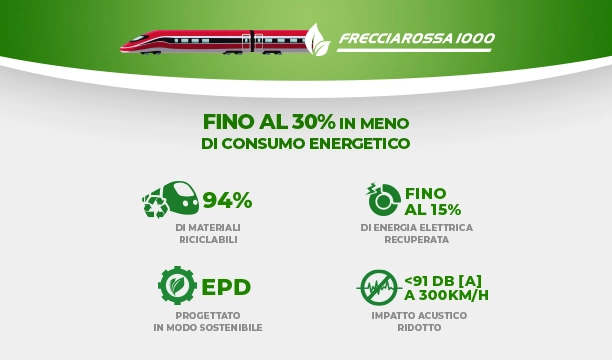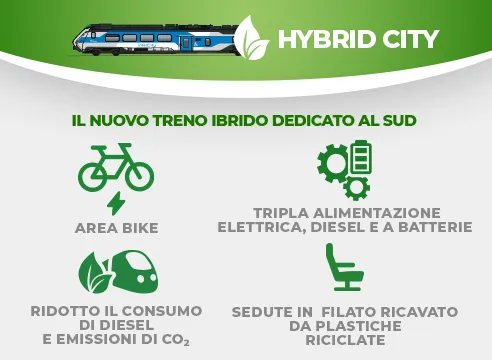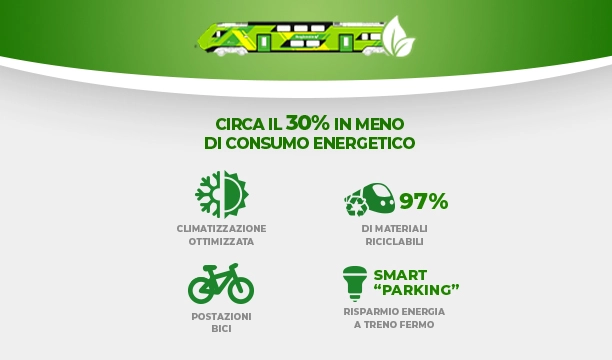
For years, Trenitalia has based its selection of trains and on-board services on its attention to environmental performance and passenger comfort.
Frecciarossa 1000
The Frecciarossa 1000 is the first high-speed train in the world to have obtained environmental product declaration (EPD) based on a careful Life Cycle Analysis (LCA).
The reduced aerodynamic resistance ensures a high quietness level (< 91 dB[A] during transit at 300km/h) and minimal vibrations.
Every detail, from the light alloys it is made of to the new electric motors that drive it, has been designed to minimise energy consumption, which is up to 30% less than the previous Frecciarossa model.
Like the most modern hybrid cars, the Frecciarossa 1000 uses braking to recover energy, returning up to 15% of the current drawn to the power grid.
Maximum attention has been paid to the recyclability of the materials constituting the Frecciarossa 1000 right from the design phase, allowing it to have a contained environmental impact even beyond the end of its life cycle, since the materials used for its construction are 94% recyclable.
Great consideration has also been given to comfort and the travel experience. In particular, all trains are equipped with an LED lighting system, on-board monitors for travel information and news, power outlets, seats for transporting passengers in wheelchairs and a multi-operator Internet connection system (New WiFi Fast) that guarantees fast and stable browsing.

New Hybrid Intercity
The first latest generation hybrid Intercity train made its debut journey on 25 March, connecting Reggio Calabria to Taranto. Other trains will gradually begin to run subsequently.
The train features new seats that use fibres made from recycled plastics, and there is a new name for the First Class – Plus (32 seats) – and Second Class – Easy (168 seats) service levels
- Bike area with the possibility to charge e-bikes (carriage 1-3)
- Vending machine area for snacks and hot/cold drinks (carriage 2)
- PRM seat adjacent to PRM toilet (carriage 4)
The new vehicles will be sustainable, innovative, offering a more comfortable and environmentally friendly service.
HYBRID CITY, powered by a combination of electricity, diesel, and batteries, reduces diesel consumption and CO₂ emissions

The new Regional trains
The New Regional Trains have high environmental performance and in 2017 they were ranked in the top ten national initiatives for sustainable mobility.
Double-decker electric train
The double-decker electric regional train, designed and built by Hitachi Rail STS for Trenitalia, represents a generational leap compared to the current double-decker rolling stock in service in Italy, with unique performance on the market in terms of consumption: about 30% less than the previous generation trains.
Right from the design phase, particular attention has been paid to environmental aspects through the use of raw materials from recycling, materials with high levels of recyclability (97%) and adopting innovative technologies for energy efficiency.
The air conditioning uses a high-performance system that makes it possible to optimise performance based on the actual number of passengers on board using CO2 sensors and, consequently, to improve thermal comfort.
The internal and external lighting system uses LEDs and the “smart parking” mode saves energy even when the train is stopped, giving the train a reduced ecological footprint.
The double-decker electric train places a lot of focus on the passenger travel experience by offering state-of-the-art seats with a design capable of optimising ergonomics, large glass surfaces in the compartments for high transparency with the outside, the availability of bicycle stations and the optimisation of accessibility for people with reduced mobility.

Single-decker electric train at 200Km/h
The single-decker electric trains designed and built by Alstom Ferroviaria for Trenitalia are technologically advanced, comfortable, environmentally friendly and easily customisable.
The new trains are 95% recyclable, with no solvents or other toxic chemicals used in their production process, and they consume 30% less energy than the previous generation trains.
The LED interior lighting has been optimised thanks to large windows that allow more natural light to enter
The structure and insulation of the aluminium case help to improve thermal insulation by reducing the cooling and heating times of the passenger space, and the programmed door closure avoids heat loss.
The noise and vibration levels have also been minimised to ensure a peaceful and undisturbed journey.
Its transport capacity is up to 15% higher than the previous generation and it also has up to 12 bicycle racks.
Single-decker hybrid train
The single-decker hybrid train, designed and built by Hitachi Rail STS, is able to run on both electrified and non-electrified lines as it is equipped with latest generation engines, pantograph for electrified lines, Diesel for non-electrified lines and batteries to cover the last mile.
This hybrid technology makes it possible to reduce fuel consumption by 50%, and also the environmental impact compared to traditional diesel engines, while also offering excellent performance in terms of comfort and safety.
In particular, thanks to batteries, the trains can travel on some non-electrified sections of the line (for example, when approaching residential areas or during station stops), significantly reducing pollutant emissions and noise.
These trains are more than 95% recyclable and are equipped with the most modern technologies designed to serve people: these include a closed-circuit surveillance camera system, a passenger information system based on highly visible 24"monitors, availability of bicycle spaces, an indoor and outdoor LED lighting system, intelligent consumption management for the air conditioning system, Smart Parking and optimisation of accessibility for people with reduced mobility.
The single-deck hybrid train is the first train in the world to have obtained the Social Product Declaration (SPD) certification, validated by a third party. This certification quantifies the social impacts that the train has on stakeholders along the value chain.